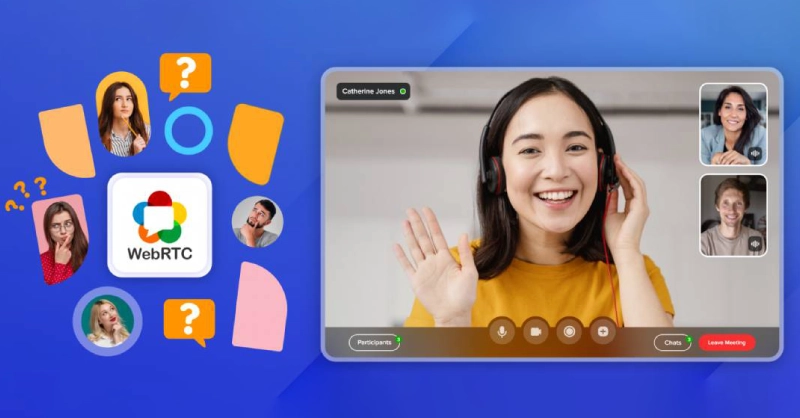20 WebRTC Video and Voice Call FAQs [Tips & Expert Insights]

Planning to Build Video Chat Apps with WebRTC technology?
As a developer, we’re sure you know the pressures associated with the development process right from first planning to final deployment. Every stage of the process differs and there can be so many questions you need answers to.
Thereby, we have compiled a list of the top 20 questions to ask before you start building an amazing online video call app with WebRTCs.
Top 20 FAQs to Build A WebRTC Video Calling App
1. How to make one-to-one video calls?
A WebRTC video call typically involves conversations via web browsers installed on your mobile or computer.
To make a one-to-one video call you have follow the below given steps,
- Open the app on your web browser
- At the top of the application, go to search contact or dial a number that you want to connect with.
- Tap the specific contact number to connect over the call.
- Choose an option to proceed,
- To make a video call, tap on the video call icon in the app.
- To make an audio call alone, tap on the voice call icon in the app.
2. How do I make a WebRTC group video call?
For any group video call to work, it is necessary to create a group first, thereafter you are supposed to use the video calling options. But, if you’ve already created a group then things are most simple for you to proceed with, you can simply tap on the green message button that’s present at the lower-right corner of the display and create a new chat conversation. Learn More Top Group Video Call Apps
3. How does a group video call work technically?
In technical terms, video call works through a technology called VoIP (Voice over Internet Protocol). This is the technology that is used to make a voice and live video call within the device. VoIP enables the users to make video calls from any device mostly via the VoIP phones and WebRTC enabled-browsers.
Furthermore, when the data moves across using this technology, the VoIP service will convert the user’s voice from audio signals to digital data, and then send it to another user or group of users over Ethernet or Wi-Fi, for which VoIP makes use of codecs (can either be a hardware- or software-based process that compresses and decompresses large amount of VoIP data).
4. How many people can join a video call at once?
In a video call, around eight participants can join at once on both iOS and Android devices, when you use MirrorFly APIs and SDKs. All this includes secured messages, voice, and video call notes with end-to-end encryption.
5. What is WebRTC used for?
WebRTC is a real-time communication technology that allows the web applications and sites to capture and stream audio/video files whenever needed. It also lets the user exchange the arbitrary data among the browsers without the need of an intermediary.
6. How many participants can join a WebRTC Video Call?
WebRTC is a peer-to-peer mesh system that works perfectly for one-to-one video call and for small groups of people up to 6 users in a room. If you try to have more users like around 16 and so, then there may be chances for its local wifi access points in the office to get crashed as the peer-to-peer mesh approach creates a direct impact on the network.
7. Can WebRTC be used on mobile apps?
Definitely a yes! The WebRTC protocol is device and platform-independent and so can be implemented as an open web standard on all mobile devices. Be it Android, iOS, or browsers like Microsoft Edge, Google Chrome, Mozilla Firefox, Safari, Opera, BlackBerry, and Vivaldi, WebRTC technology supports any OS with simple JavaScript APIs.
8. Can I use WebRTC in Java?
Yes, of course, you can get the WebRTC in Java frames whenever you are implementing the WebRTC in your server code, mostly by using webRTC native APIs. Here, the connection is peer-to-peer where one is the web browser and another one is your server.
9. How does WebRTC video call work?
Let’s have a quick check on with WebRTC’s work process,
- First WebRTC sends the data directly across the browsers to peer-to-peer.
- This transmitted data will be found in voice, chat or video format in real time.
- Later, in the further process, the WebRTC uses NAT traversal mechanisms for browsers to reach one another.
- For which the P2P moves across a relay server (TURN).
- When you are using WebRTC, you must keep a note of signaling and media that are different from each other.
- The tech over here enables peer-to-peer (browser to browser) interaction with very few intervention of a server.
- This intervention of a server is most likely to be used only for signaling.
- The possibility to hold the video calls increases with multiple participants via peer-to-peer communication.
- Even the media servers help in reducing the number of streams a client needs to send or receive.
10. How do I improve video quality with WebRTC?
To improve the video quality, a fair choice has to be made between the frame rate and resolution. This can be achieved by opting for VBR instead of the default CBR option in WebRTC. By doing this, one can aim for higher resolution with lower frame rate for static content and vice-versa in case of talking-heads domain.
11. How do I create a WebRTC video conferencing application?
To create a WebRTC video conferencing app you need to have a WebRTC solution for your device. This is so as the WebRTC framework allows the browser and your device to communicate in real-time with APIs.
Once you get with that you can proceed with the establishment of your browser-based video chat using HTML and JavaScript with no back-end code requirement. By that time, for WebRTC you have to establish a peer-to-peer audio/video connection using STUN/TURN server that will also act as a signaling server.
12. How to Build a Video Call & Voice Chat App With Integration of WebRTC Protocol?
Using WebRTC APIs to build video and voice applications is as easy as ABCs. The APIs ensure developers implement these features in a hassle-free way. Further, this article can help you give a quick walkthrough on the key factors involved in creating an application.
13. How To Develop A Video Chat App With JavaScript And WebRTC?
These days it has become the trend to use WebRTC protocol for implementing voice calling and video calling features to all chat platforms. Here’s how you can easily create a video chat app with JS and WebRTC.
14. Does WebRTC require a server?
In technical terms, WebRTC strictly don’t prefer signaling servers as long as you have other possible ways to achieve or receive an SDP offer to your peer in return. However, WebRTC can easily connect two browsers on a local area network where it needs a server to handle the tasks like moving across the firewalls or routing data outside of the local network, etc.
15. Is WebRTC peer-to-peer?
Yes, Of course. WebRTC has been designed to work peer-to-peer that enables the users to connect by the most direct possible route. Although it is built to move along with real-world networking, here the client application needs to traverse NAT gateways and firewalls.
16. How to Build a P2P Video Call App Using WebRTC And Node.Js?
To build a P2P video call app, one must initially take a quick note on testing and debugging, understanding the HTML5 backbone, importing jQueries, and then preparing to receive calls, and a few others which this article may help you with.
17. Is WebRTC open source?
Absolutely! WebRTC is a free and open-source project that allows the real-time communication of messaging, audio and video APIs for the web through your web browser and mobile application. It supports capturing, streaming, and exchange of data between the web browsers.
18. Is WebRTC only for video?
No, WebRTC is a full-fledged peer-to-peer technology that is meant for real-time communication exchange of audio, video, and text data with one central caveat. In addition, it also supports creating group calling services, building a video conferencing solution with video call recording, etc.
19. How does WebRTC reduce latency between devices?
Everybody wishes to experience lag-free video quality and the key to low latency or ultra-low latency is the usage of WebRTC technology. WebRTC uses UDP (User Datagram Protocol) for faster delivery of packets between sender and recipient (without establishing a handshake), and RTP protocol for video transmissions over the internet and other IP networks.
20. Is WebRTC secure?
Of course, WebRTC is safe and secure with Secure Real Time Protocol (SRTP) encryption and other standards of security protocol that are necessary for all WebRTC sessions. Moreover, it does prohibit the creation of unencrypted WebRTC connections using the Internet Engineering Task Force (IETF) standards.
Drive 1+ billions of conversations on your apps with highly secure 250+ real-time Communication Features.
Contact Sales200+ Happy Clients
Topic-based Chat
Multi-tenancy Support

Further Reading
- WebRTC Video Call API: The Definitive Guide
- Top 7 Picks Of WebRTC Alternatives For 2026
- Top 7 WebRTC API Platforms for Video Call 2026
- Build A WebRTC Video Calling App With Janus Server